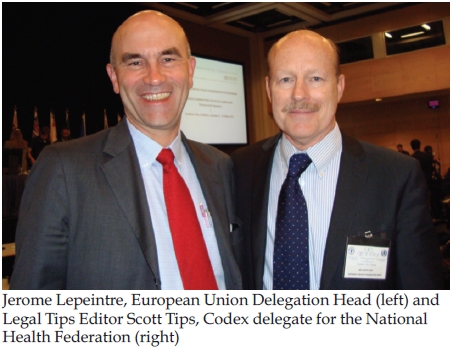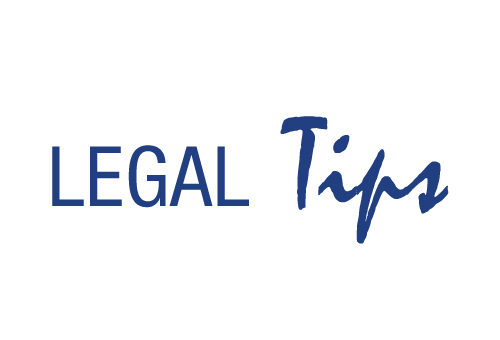Editor’s Note: This article is intended for information purposes only. Because state and municipal laws vary greatly, as do the circumstances of individual cases, readers are advised to contact an attorney for specific legal advice. © Scott C. Tips 2011
After some 18 years and seemingly interminable debates between two sharply divided camps, the Codex Committee on Food Labelling (CCFL), at its 39th session held in Quebec City, Canada, the week of May 9–13, 2011, finally reached a consensus on a watered-down labeling guideline for genetically modified organism (GMO) foods. No thanks to the blocking efforts of the United States, Canada, Mexico, Argentina, Costa Rica and Australia, this Guideline does not require mandatory labeling of GMO foods. However, what it does accomplish is to provide protection from the World Trade Organization (WTO) for those countries that require GMO foods to be labeled as such. In that sense, it is a huge victory.
Or, it will be. First, the Guideline—which is currently called the “Proposed Draft Compilation of Codex Texts Relevant to Labelling of Foods Derived from Modern Biotechnology”—must be adopted by the Codex Alimentarius Commission at its meeting in Geneva this July. The National Health Federation (NHF) will be in attendance there. While it is likely that the Guideline will be adopted at that meeting, it is also entirely possible that it could be sent back to CCFL for further review. Nothing is assured.
The Camps
The debate over whether or not GMO foods should be labeled so that the consumer may know what he or she is buying has been a heated Agenda item at CCFL meetings for almost 20 years now. The Western Hemispheric countries of Canada, the United States, Mexico, Costa Rica, Chile and Argentina (but not Brazil or Bolivia) have taken a united stand against the mandatory labeling of GMO food products because they have known that consumers, by a vast majority, even in their own countries, will shun GMO foods.
So, for years these countries’ delegations at Codex have been opposing GMO labeling so they can continue to push their GMO-rich crops on unsuspecting consumers. At Codex, they are supported by several industry INGOs such as the Biotechnology Industry Organization (BIO) and the International Council of Grocery Manufacturers (ICGMA).
On the other hand, the Old World and Developing World countries are in favor of the consumer being informed on this issue, that is, that the consumer have the choice when shopping to know whether he or she is buying GMO foods. The countries that have taken a consistently strong stand in favor of GMO labeling are the European Union, France, Germany, Hungary, Norway, Switzerland, Morocco, Kenya, Cameroun, Ghana, Mali, and the always outspoken Malaysia, supported by the consumer INGO delegations of Consumers International, International Baby Food Action Network (IBFAN), and of course the National Health Federation. Importantly, the EU delegation head, Jerome Lepeintre, was the cool, steadfast leader of the pro-labeling forces that finally achieved a positive result.
The Debate
After many years of frustrated effort to advance a Guideline for the labeling of GMO foods, after the Physical Working Group meeting in Oslo, Norway in early 2007 (which NHF attended) and its second meeting in Accra, Ghana (which NHF did not attend), and after all of the regular sessions of CCFL over the years, all of the parties knew that this issue was coming to a “make it or break it” point. That is why the CCFL Chairman held a two-day “facilitated” work session last November in Brussels so as to achieve a compromise between the two camps. (To read the report of that meeting, see ftp://ftp.fao.org/codex/ccfl39/fl39_13e.pdf.)
Out of the November 2010 facilitated session came three options expressed in a very-basic guideline drafted by its attendees. It was this watered-down document that was presented to the delegates at the recent CCFL meeting in Quebec this month that provided the basis for the final debate. Both sides knew that if no consensus were reached in Quebec this year, then the document might die on the table altogether. On the other hand, no delegation wanted to be perceived as the party that killed the patient. Hence, there was a certain political gravitational force pulling the two camps together toward a consensual fusion.
But that fusion still did not arrive without a certain amount of diplomatic kicking, screaming and eye-gouging along the way. At one point, and in an emotion-laden voice, the U.S. delegate drew a line in the sand when she said that the Committee could not delete from the Guideline the following sentence: “This document is not intended to suggest or imply that foods derived from modern biotechnology are necessarily different from other foods simply due to their method of production.” Of course, the U.S. position on this, supported by the usual suspects, was nonsensical as GMO foods are very different. Otherwise, why was the Committee even having this matter as a distinct Agenda item for 18 years?
On the other hand, the European Union and its allies (including NHF) drew its own line in the sand and kept its desired wording generally intact: “Different approaches regarding labelling of foods derived from modern biotechnology are used.” Keeping this language in the Guideline could provide protection from the WTO for national-level GMO-labeling regulations around the world.
As the Committee word-smithed its way through the Guideline, it adopted NHF’s suggestion that a heading be used for Section 3 of the Guideline, and the language NHF proposed for the heading was adopted with some changes. Interestingly enough, this heading ended up becoming the compromise between the two camps on this section that allowed certain other disputed language to be deleted and final consensus on the Guideline to be reached—almost.
In one last effort to minimize the impact of the document, the U.S. delegate proposed that the Guideline be attached to the Codex General Guidelines on Claims. The usual suspects agreed, but most delegates, and even the Chairman, did not. The final verdict: The Guideline would be a standalone document and be published as such. (The Guideline is also attached to the end of this article.)
The Result
Both sides respected the other’s lines in the sand and, in the end, a document emerged from the process that was set at Step 5/8 (near-final Step) for consideration to be adopted by the Commission in July. This confirms what NHF wrote after last year’s meeting, that the momentum was on the side of the pro-labeling forces and not, as some had wrongly written, against us.
While the document does not mandate global labeling of GMO foods, and in that respect, the United States was successful in avoiding any harsh, new rule, the Guideline that emerged from this meeting was still a great victory because it will provide WTO cover for those developing nations resisting U.S. pressure on them to accept GMO seeds, crops and foods.
In other forums, the United States has argued that it will seek WTO sanctions for any country’s failure to accept GMO food products; and for poor countries not able to afford the battle, this threat has been a huge club over their heads, leading sometimes to reluctant acceptance of GMO technology. When this Guideline is finally adopted, however, the United States will no longer be able to use this club effectively since the developing countries can point to a Codex document—enforceable by WTO—that says that Codex has authorized and accepted the labeling of GMO foods. Various wording throughout the Guideline supports the right of individual countries to enact and enforce labeling of GMO foods.
That this fight has always been a trade issue for the United States and Canada was most evident during this Codex meeting when the U.S. Department of State had its man sitting at the table and calling the shots for the U.S. delegation while the Canadian Department of Foreign Affairs, Trade and Commerce woman did the same for the Canadian Codex delegation. Neither health nor consumer rights were on those delegates’ minds; rather, it was business as usual—selling ill health to the world. As Police Chief Marge Gunderson remarked to the just-captured suspect near the end of the 1996 film Fargo, “I can’t believe you did all that for a little money. Don’t you realize there is more to life than money?” WF
A graduate of the University of California at Berkeley Law School, Scott C. Tips currently practices internationally, emphasizing Food-and-Drug law, business law and business litigation, trade practice, and international corporate formation and management. He has been involved in the nutrition field for more than three decades and may be reached at (415) 244-1813 or by e-mail at scott@rivieramail.com.
Proposed Draft Compilation of Codex Texts Relevant to Labelling of Foods Derived from Modern Biotechnology
1. Purpose
The purpose of this document is only to recall and assemble in a single document some important elements of guidance from Codex texts, which are relevant to labelling of foods derived from modern biotechnology.
2. Considerations
Different approaches regarding labelling of foods derived from modern biotechnology are used. Any approach implemented by Codex members should be consistent with already adopted Codex provisions. This document is not intended to suggest or imply that foods derived from modern biotechnology are necessarily different from other foods simply due to their method of production.
3. Compilation of relevant Codex texts
3.1 The Codex General Standard for the Labelling of Prepackaged Foods, (Codex Stan 1-1985); and particularly, Sections 3.1, 3.2, 4.1.1, 4.1.2, 4.2.2, 7.1
3.2 The Codex General Guidelines on Claims (CAC/GL 1-1979); and particularly, Sections 1.2, 1.3, Section 2 – Definition of Claim, 3.3, 3.5, 4.1, 5.1(iii), 5.1(iv), 5.1(v), 5.1(vi)
3.3 The Codex Guidelines for Use of Nutrition and Health Claims (CAC/GL 23-1997); Introduction and particularly, Sections 1.1, 1.2, 1.3, 1.4 and 1.5
3.4 The Codex Guidelines for the Production, Processing, Labelling and Marketing of Organically Produced Foods (CAC/GL 32-1999); and particularly Section 1.5
3.5 General Guidelines for Use of the Term Hallal (CAC/GL 24-1997)
3.6 Working Principles for Risk Analysis for Food Safety for Application by Governments (CAC/GL 62-2007)
3.7 Principles for Risk Analysis of Foods Derived from Modern Biotechnology (CAC/GL 44-2003); and particularly, Paragraph 19.
3.8 Guidelines for the Conduct of Food Safety Assessments of Foods Derived from Recombinant-DNA plants (CAC/GL 45-2003)
3.9 Guidelines for the Conduct of Food Safety Assessments of Foods Derived from Recombinant-DNA microorganisms (CAC/GL 46-2003)
3.10 Guideline for the Conduct of Food Safety Assessment of Foods derived from Recombinant-DNA Animals (CAC/GL 68-2008)
Published in WholeFoods Magazine, August 2011










